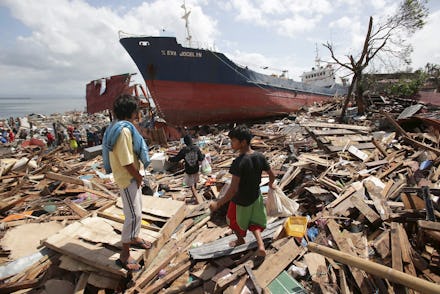8 Photos Capture the Damage Climate Change is Already Doing to the World

Climate change is not an abstract, existential threat. With rising sea levels and increased incidences of extreme weather events, it is rapidly becoming a problem that has serious and harmful effects in the here and now on a growing number of people.
While it's very difficult to blame any single weather phenomenon on global warming and a changing climate, scientists believe that events like the ones captured in these 8 photos are more likely to occur in the future and with worsening intensity unless worldwide carbon emissions slow down.
1. Bangladeshi floods
Rising temperatures, land degradation due to saline pollution of freshwater, and an increasing number of extreme weather events are already displacing Bangladeshi farmers from their land. According to the New York Times, rising sea levels may force 18 million people in Bangladesh from their homes over the next 40 years.
2. Coral bleaching
Skeptical Science reports that approximately 1% of the world's coral is dying off each year, with warmer oceans playing a huge role in the process. Warmer ocean temperatures stress corals, causing them to eject symbiotic algae crucial for their survival. While recent research has suggested corals may be able to adapt to hotter oceans in the long run, reefs are dying at unprecedented rates.
"Temperatures projected under even mild climate change scenarios may be too damaging to coral reefs for them to survive beyond the mid to late part of this century," University of Queensland professor Ove Hoegh-Guldberg told the Guardian amid reports of mass bleaching in the Pacific Ocean last year.
3. Heat waves in Pakistan
USA Today reports that as of June 26, at least 1,150 people had died over the course of a scorching heat wave in Pakistan that reached up to 112.6 degrees Fahrenheit at its peak.
"The deadly heat wave that has killed several hundred people in Karachi, Pakistan, is clearly a harbinger of things to come with the changing climate," International Center for Climate Change and Development in Bangladesh director Saleemul Huq told USA Today. "Even if this particular event cannot be unequivocally attributed to human-induced climate change, we can certainly expect such heat waves with greater frequency in future."
4. Drought in the Middle East
In March, researchers published a study tying worsening conflict conditions in Syria in 2011 to a devastating and unprecedented drought from 2006 to 2009.
According to the New York Times, the scientists connected the drought to the displacement of up to 1.5 million people from rural to urban areas shortly before the violent uprising against President Bashar al-Assad began in 2011. Assad's government had mismanaged its response to the drought, resulting in crop failures that rendered large numbers of Syrians unemployed. Thus, extreme environmental conditions linked to climate change helped worsen the nation's political situation and the ongoing Syrian civil war.
Other research has suggested that the Tigris-Euphrates river basin is losing water faster than almost any other place in the world, pointing to potential economic and civil repercussions.
5. Hurricane Sandy
ThinkProgress reports that some climate researchers think that damaging storms like Hurricane Sandy, which destroyed $65 billion worth of property and killed more than a hundred people, are more likely to result as a symptom of global climate change.
One research project from NOAA found that, thanks to rising sea levels, storm surges as damaging as Sandy's are twice as likely as they were in the year 1950.
For an alternate perspective, the Washington Post's Jason Samenow writes that while researchers do not currently believe it is accurate to say that climate change caused Hurricane Sandy, it did make its impact worse, particularly via higher sea levels.
6. Beach erosion in Florida
Skepticism about global warming has hampered the Republican-controlled state's ability to prepare itself for rising sea levels, which the Associated Press reports are already a "daily reality in much of Florida. Drinking water wells are fouled by seawater. Higher tides and storm surges make for more frequent road flooding from Jacksonville to Key West, and they're overburdening aging flood-control systems."
The Organization for Economic Co-operation and Development estimates that the city of Miami alone has approximately $416 billion in assets at risk of storm-related flooding or damage, while the New York Times reports that scientists expect sea levels to surge up to two feet in the area of southeastern Florida by the year 2060.
7. Glaciers melting in Alaska
NASA-provided images show Muir Glacier in Alaska, which has melted rapidly in recent decades. According to NASA scientists, "from 1941 to 2004, the front of the glacier moved back about seven miles while its thickness decreased by more than 2,625 feet."
8. Torrential rain in Colombia
The Guardian reports that 3 million people became disaster victims and 425 died in 2011 after unusual levels of rainfall affected more than 75% of the country for months. Some 12,000 homes were destroyed and 356,000 others damaged.
"Over the past 10 months we have registered five or six times more rainfall than usual," weather expert Ricardo Lozano told the Guardian. He added that the weather phenomenon La Niña, responsible for the rainfall, "used to occur once every five to six years, but it is increasingly frequent and severe due to global warming."
The Washington Post also reported that lack of adequate government preparation and lax or nonexistent compliance with environmental safety regulations also contributed to the impact of the storms. For example, unsafe practices such as allowing construction on flood plains or rerouting drainage routes exposed many people who would otherwise be safe to damaging floods.